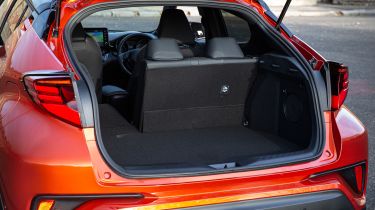Toyota C-HR SUV - Practicality & boot space (2016-2023)
The Toyota C-HR belies its slinky styling with a more practical, versatile interior than we expected
The Toyota C-HR has svelte, curvaceous styling and isn’t the sort of car we’d usually single out as offering the last word in practicality. We were very pleasantly surprised, then, to find that it’s far more useable than we anticipated.
Although it looks compact next to rivals, this is mainly down to the clever way the car is styled. In fact, the C-HR takes up as much road space as its most immediate rivals, the Nissan Qashqai and SEAT Ateca. Of course, the absence of bulky, square edges mean that more conventionally styled crossovers have the edge for outright practicality, but by no means is the C-HR too badly compromised to make a useful family car.
Toyota C-HR interior space & storage
The driver and front passenger are treated to plenty of leg-stretching space, with a wide range of seat adjustment and a vantage point rather higher than that of a traditional hatchback. This, combined with the low dashboard and big windscreen, makes for a panoramic view out.
Even rear-seat passengers have a decent amount of legroom, with the front seats mounted high enough to tuck your feet under. Given the sloping roofline, there’s a surprising amount of headroom, too, though three adults side-by-side may feel a little tight on shoulder room. The view out is a little limited to the sides, too, due to the wide roof pillars.
More reviews
The rear doors are stealthily concealed thanks to door handles hidden in the roof pillars, but open wide to reveal a generous aperture through which entry to the rear seats will be easy for all but the tallest passengers.
Families will be grateful for the plentiful interior stowage, with big door bins that’ll easily hold 500ml drink bottles, a large glovebox on the passenger side and a lidded container between the front seats. Smartphones fit well into the trinket tray ahead of the gearlever, too.
Boot space
The Toyota C-HR has a large, wide-opening tailgate with a low loading lip, beyond which lurks a well shaped loadbay, usefully free of awkward intrusions from the suspension and structure beneath the skin.
Measuring at 377 litres with the rear seats in place, it’s a large space compared to what you get in regular compact hatchbacks, but rather less spacious than more conventionally shaped crossover SUV rivals – the SEAT Ateca, for instance, boasts a 485-litre capacity.
Naturally, a 60:40 split-folding rear seat is provided to boost the C-HR’s versatility, although they’re folded from handles within the car, rather than accessible from the boot. The resultant load bay with the seatbacks stowed is relatively flat, but Toyota hasn’t issued actual figures for total capacity.
Which Is Best?
Cheapest
- Name1.8 Hybrid Icon 5dr CVT
- Gearbox typeAuto
- RRP£31,440
Most Economical
- Name2.0 PHEV Design 5dr CVT
- Gearbox typeAuto
- RRP£39,230
Fastest
- Name2.0 PHEV Design 5dr CVT [Bi-tone]
- Gearbox typeAuto
- RRP£39,580













